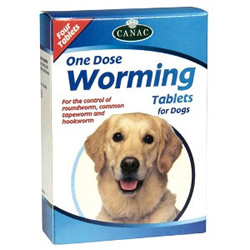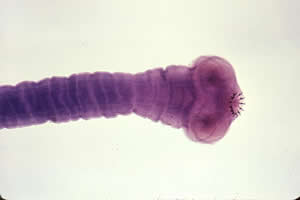Canine worms
 Canine worms are internal parasites that can be a serious health risk to dogs if left untreated and may infect and cause disease in humans. There are five kinds of canine worms: tapeworm, hookworm, whipworm, roundworm and the most dangerous heartworm. Infected dog feces contain millions of worm eggs that scatter all over the place. Children and adults can get infected if they pick up these worm eggs. You should get your dog wormed for intestinal worm (tapeworm, hookworm, whipworm and roundworm) every three months to prevent canine worm problems in your household; heartworm prevention should begin at 12 weeks of age and must continue throughout the dog’s life. Always be on the lookout for symptoms of canine worms, including coughing, vomiting, diarrhea, low energy level, pot belly, loss of appetite and dramatic weight loss. If your pet has caught canine worms, over the counter worming medications are widely available. Or you can take a stool sample to your veterinary clinic for examination; the vet would then prescribe the proper treatment for your dog.
Canine worms are internal parasites that can be a serious health risk to dogs if left untreated and may infect and cause disease in humans. There are five kinds of canine worms: tapeworm, hookworm, whipworm, roundworm and the most dangerous heartworm. Infected dog feces contain millions of worm eggs that scatter all over the place. Children and adults can get infected if they pick up these worm eggs. You should get your dog wormed for intestinal worm (tapeworm, hookworm, whipworm and roundworm) every three months to prevent canine worm problems in your household; heartworm prevention should begin at 12 weeks of age and must continue throughout the dog’s life. Always be on the lookout for symptoms of canine worms, including coughing, vomiting, diarrhea, low energy level, pot belly, loss of appetite and dramatic weight loss. If your pet has caught canine worms, over the counter worming medications are widely available. Or you can take a stool sample to your veterinary clinic for examination; the vet would then prescribe the proper treatment for your dog.
Different Canine Worms
A tapeworm like this attaches to the small intestinal wall by the hook-like mouthparts. Adult canine worms may reach 8 inch in length before the tail end breaks off with millions of worm eggs. The tail end pass into the stool and can be seen like rice grains crawling near the anus or surface of dog poo. The eggs are released when the segment dries to a golden color and can sometimes been seen stuck to the hair around the dog's anus.
Your dog can become infected with tapeworm by swallowing an infected flea or eating rodents carrying the canine worm. As the infected flea or rodent is digested within the dog's intestine, the tapeworm hatches and hooks into the intestinal lining.
Roundworms are so common that most dogs are born with them. Whether or not they show signs of infection, puppies should be d ewormed every 2 weeks until they are 8 weeks old. Then they can be started on preventive medication. While roundworms usually are less problematic than other canine worms, they can be big trouble for puppies, especially if there are a lot of them. Puppies with roundworms look thin, except for their potbelly. Other symptoms of roundworm include frequent vomiting or diarrhea. A rough, dull coat is another sign of roundworm infestation. Puppies with a heavy load of roundworms may develop a cough or even pneumonia.
ewormed every 2 weeks until they are 8 weeks old. Then they can be started on preventive medication. While roundworms usually are less problematic than other canine worms, they can be big trouble for puppies, especially if there are a lot of them. Puppies with roundworms look thin, except for their potbelly. Other symptoms of roundworm include frequent vomiting or diarrhea. A rough, dull coat is another sign of roundworm infestation. Puppies with a heavy load of roundworms may develop a cough or even pneumonia.
Hookworms are most common in warm, humid climates. Tiny hookworm larvae penetrate the skin, usually through the feet, or are transmitted to pups through their mother's milk. They can also be ingested from the environment. Once inside the dog, hookworms migrate to the small intestine, where they latch onto the intestinal wall and suck blood from it. Signs of hookworm infection include diarrhea, weakness, and weight loss. Like some other canine worms, hookworms can be passed to people.
Heartworms are most serious and potentially fatal. This canine worm is called heartworm because it lives in the heart and major blood vessels of dogs. Heartworm larvae enter a dog's body through mosquito bite, after which it takes 6-7months to mature and start reproducing. Signs of heartworm disease weight loss, cough during exercise or even pass out after exertion. Heartworm diseased is diagnosed through blood-concentration tests. Radiographs of the heart and lungs are the best way to evaluate the severity of heartworm infection. This canine worm is treated by using drugs to poison the adult worms and eliminate them from the dog's system. The dog must be hospitalized during treatment so he can be monitored for possible complications such as obstruction of arteries by dead worms.
Is canine worms infectious to people?
Yes if a human ingests an infected flea. Most cases involve children that play in the same contaminated areas as the dog. The most effective way to prevent human infection is through flea control, picking up dog feces daily and annual fecal examination.
How to prevent canine worms?
Prevention is far better than treatment. Not only is it safer for the dog but it's also much more cost-effective. Several types of medication are available for the prevention of canine worms. Consult your veterinarian to see which drugs are suitable for your dog. Bare in mind that some medications must be given under certain conditions; for example, with food or on an empty stomach. Be sure to check with your veterinarian how to administrate the drug including whether it can be pulverized and mixed with dog food.
